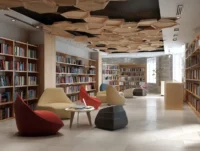Creating architectural diagrams can be both an art and a science. With the right tools, we can transform complex ideas into visually stunning representations. Isometric Photoshop brushes have become game-changers in this field, offering precision and style that traditional methods often lack.
In this article, we’ll explore how to master these powerful tools to elevate our architectural diagrams. Whether we’re seasoned designers or just starting, understanding the nuances of isometric brushes in Photoshop will help us create more dynamic and engaging visuals. Let’s dive into the world of isometric design and unlock new possibilities for our architectural presentations.
Understanding Isometric Brushes
Isometric brushes replicate three-dimensional objects on a two-dimensional plane, enriching architectural diagrams by providing depth and perspective. These brushes align grid-based designs, making them ideal for illustrating complex structures accurately. They save time by automating repetitive drawing tasks, allowing more focus on creativity and innovation.
Features of Isometric Brushes
- Precision: Isometric brushes maintain exact angles, ensuring consistency in designs.
- Versatility: Suitable for various elements like buildings, furniture, and landscapes.
- Efficiency: Reduce manual drawing time by providing pre-designed templates.
Applying Isometric Brushes in Photoshop
Using these brushes begins with setting up an isometric grid. Follow these steps:
- Create a Grid: Go to Preferences > Guides, Grid & Slices, and customize the grid settings to 30° for the isometric effect.
- Select Brush: Choose an isometric brush from the brush preset menu.
- Apply: Draw on the canvas, watching how the brush adheres to the isometric grid for accurate representation.
Customizing Isometric Brushes
Personalize brushes to suit specific projects. Adjust brush settings in the Brush Panel:
- Angle: Change the brush angle to fit unique design requirements.
- Spacing: Modify spacing for smoother strokes.
- Shape Dynamics: Alter shape dynamics to create varied line weights.
Benefits in Architectural Diagrams
Incorporating isometric brushes enhances diagrams by offering:
- Realism: Simulate real-world objects for lifelike representations.
- Clarity: Produce cleaner and more understandable visuals.
- Impact: Create striking, professional-quality presentations that impress clients and stakeholders.
Mastering isometric Photoshop brushes opens new horizons in architectural design, merging precision with creativity for standout diagrams.
Setting Up Photoshop for Isometric Drawings
Mastering isometric Photoshop brushes begins with a proper setup of the software. We ensure our Photoshop environment is optimized for isometric drawings to enhance efficiency and precision.
Required Tools and Plugins
We need specific tools and plugins to streamline the isometric drawing process. A few essential items include:
- Photoshop CC: Ensures access to the latest features and updates.
- Isometric Grids: Found online or created within the software, these grids facilitate accurate alignments.
- GuideGuide Plugin: This plugin creates custom grids and guides quickly, improving workflow.
- Isometric Brushes: Downloadable from various sources, tailored for different architectural elements.
Integrating these tools in Photoshop sets the foundation for creating detailed and precise isometric drawings.
Creating a Custom Workspace
We start by arranging a workspace suited for isometric art. This involves:
- Setting up Panels: Place essential panels like Layers, Brushes, and Properties for easy access.
- Customizing the Toolbar: Add tools frequently used in isometric drawing, such as the Polygonal Lasso Tool and Pen Tool.
- Saving the Workspace: Go to Window > Workspace > New Workspace to save the layout.
A well-organized workspace fosters a more streamlined and efficient drawing process.
Mastering Isometric Techniques
To master isometric techniques, we need to understand both basic shapes and advanced compositions. This knowledge enhances our ability to create stunning arch diagrams.
Basic Isometric Shapes
Basic isometric shapes form the foundation of architectural diagrams. Start by sketching simple geometric figures like cubes and cylinders. Create these shapes using the isometric grid in Photoshop, ensuring accurate alignment. The GuideGuide plugin simplifies this process by providing easy grid access and alignment tools. Spend time practicing these shapes, as they provide the building blocks for more complex compositions. Adjust brush settings to achieve clean, precise edges, giving our designs a polished look.
Advanced Isometric Compositions
Advanced isometric compositions require a combination of basic shapes to form intricate designs. Use layers to manage and manipulate these shapes efficiently. Merge and intersect shapes to create complex structures such as building facades and urban layouts. Play with perspectives and lighting to add depth. Integrate textures and gradients to enhance realism. Employ Photoshop’s blending modes to merge architectural elements seamlessly. Utilize custom brushes to replicate materials like bricks and concrete. This versatility allows us to produce dynamic and detailed architectural diagrams.
Applying Isometric Brushes to Arch Diagrams
Adding isometric brushes to architectural diagrams enhances detail and precision, intricately capturing technical elements effortlessly.
Structural Components
Define primary structures first when using isometric brushes in arch diagrams. Frame basic elements like walls, floors, and roofs with the brushes for alignment with the isometric grid. Ensure each component—walls, floors, roofs—aligns accurately to the grid to maintain perspective.
- Walls: Create walls using vertical strokes on the grid lines. Use brushes with varied thickness to represent different materials. For example, thicker strokes can signify load-bearing walls, while thinner strokes can depict partitions.
- Floors: Draw floors by connecting horizontal grid lines. Use brushes tailored to textures like wood or concrete to add realism. Applying different textures helps distinguish levels and materials.
- Roofs: Form roofs by combining angled strokes and horizontal lines. Select brushes that capture roof textures, such as tiles or thatch. Consistency in brush strokes maintains uniformity in design.

Detailed Annotations
After establishing structural components, add annotations for clarity and detail. Annotate features like dimensions, materials, and functional spaces with precision and consistency.
- Dimensions: Use text and line brushes to mark measurements on the isometric grid. Indicate lengths, widths, and heights for clear understanding. Consistent use of annotation styles enhances readability.
- Materials: Highlight different materials with distinct brush patterns. For instance, crosshatch brushes can denote brick textures, while dotted brushes might represent glass surfaces. Clear labels help differentiate materials quickly.
- Functional Spaces: Mark areas such as living rooms, kitchens, and bathrooms using labeled text brushes. Incorporate symbols or icons to convey function concisely. Symbols for rooms add visual simplicity and context.
Strategically applying isometric brushes refines architectural diagrams, adding depth and clarity that resonate with the vision of precise, visually engaging designs.
Tips and Tricks for Professional Results
Using isometric Photoshop brushes for architectural diagrams requires careful technique and planning. To achieve professional-quality results, we offer several tips and tricks.

Layer Management
Organize layers meticulously. Each structural component, whether walls, floors, or roofs, needs its own layer. This separation makes adjustments easier without disrupting other elements. Group related layers, such as all walls or all floors, to streamline your workflow. Naming each layer accurately saves time when making modifications. Utilize adjustment layers for non-destructive editing, allowing modifications without altering the original artwork.
Color Schemes and Textures
Consistent color schemes enhance visual coherence. Assign distinct colors to different materials and functional spaces; for example, use a different shade for concrete and wood. Applying textures adds realism to diagrams. Use high-resolution textures that match the material being represented. Adjust opacity levels to blend textures seamlessly with the base colors without overpowering the underlying design.
Conclusion
Mastering isometric Photoshop brushes for architectural diagrams requires practice and a keen understanding of the tools available. Setting up an efficient workspace and employing precise layer management significantly enhance workflow efficiency. Organizing structural components, such as walls, floors, and roofs, on distinct layers makes modifications easier.
Using appropriate color schemes and textures also boosts the visual appeal and realism of diagrams. Applying different colors to various materials helps distinguish each element clearly, while adjusting opacity levels ensures seamless blending. By following these techniques diligently, we can create detailed and professional-looking architectural representations.
Leveraging these methods allows us to streamline our design process and achieve high-quality results. Focusing on meticulous details, from layer organization to color selection, ensures our architectural diagrams stand out with precision and artistry. Expanding our mastery of Photoshop tools can open new creative avenues and improve our overall productivity.
- Architectural illustration tools
- Architecture diagram brushes
- Best Photoshop brushes for architecture
- Digital architecture design tools
- Free isometric Photoshop brushes
- High-quality architecture brushes
- Isometric architecture brushes
- Isometric architecture drawing
- isometric design brushes
- Isometric design in Photoshop
- Isometric drawing in Photoshop
- isometric photoshop brushes
- Photoshop architectural rendering
- Photoshop architecture design
- Photoshop architecture tools
- photoshop brushes for architects
- Photoshop isometric tools
- Photoshop tools for architects
- Photoshop tools for architecture diagrams
- Stunning architecture diagrams
- Top architecture Photoshop brushes

















Leave a comment